Previous – 14. The Art Of The Swipe | Contents | Next – 16. Kirby’s Kosmic Mystery
We’re honored to be able to publish Stan Taylor’s Kirby biography here in the state he sent it to us, with only the slightest bit of editing. – Rand Hoppe
ON HIS OWN AGAIN
While scrambling at Charlton, Joe remained in contact with his buddies at Harvey. Al noticed that Dell was doing well with TV tie-ins. One of the most popular TV shows was Disney’s Davy Crockett which debuted in 1954. Now Davy Crockett was a historical figure so Disney could not copyright the character. Joe was hired to edit some of Harvey’s titles. As part of their Western Tales series Joe hired Jack to draw a Davy Crockett series. After two issues, Davy Crockett was summarily dropped and Jim Bowie was given the lead for the final issue; seemingly based on the movie “The Iron Mistress”. Boy’s Ranch tales were reprinted as back-up stories. Jack would also draw over two dozen covers for Harvey’s romance and war books the next year.
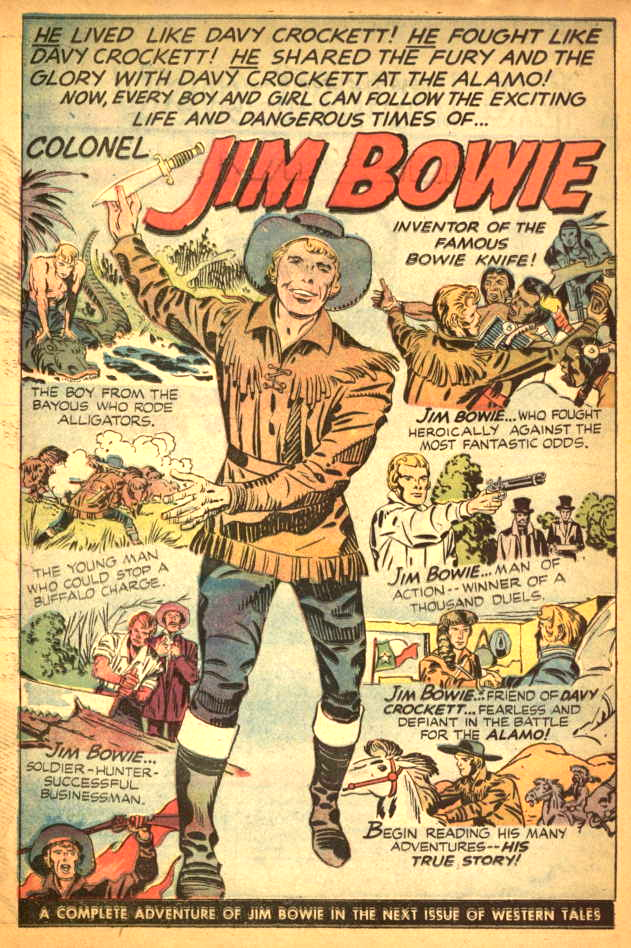
More importantly, now that S&K were no longer producing their own romance books, Prize turned their romance titles back over to Joe and Jack. Immediately they were back drawing an average of 23 pages of romance stories for three bi-monthly titles. But this was different, they were no longer 50/50 part owners, Jack was now freelancing– working for page rates. These 20+ pages a month had to carry Jack for the next year.
On Dec. 1, 1955 Rosa Parks, a black seamstress from Montgomery, Alabama refused to give up her bus seat. She was arrested. Now Rosa wasn’t naïve, she was also the secretary for the local branch of the NAACP. She knew from past experience what her actions would detail. But she was tired after a days work and had had enough. Just a few months earlier she had attended a function where the young Dr. Martin Luther King had called for more response in reaction to Emmitt Till’s death. This singular act coming so soon after the Emmett Till murder, gave rise to what was called the civil rights movement when that young minister from Atlanta, Georgia named Martin Luther King Jr. called for a citywide boycott. There were accusations that this was a planned event to showcase the plight of the blacks. The resulting boycott and lawsuit led to a Federal Court declaring that Alabama’s segregation laws were unconstitutional, and they were disbanded. The resultant violence and outrage would last for decades as blacks in other areas began demanding their dignity and civil rights.
Rosa with Dr. King – Frank Giacoia
Mama Rose had not taken Ben’s death well. Her own health began to falter and the Kirby boys decided to put her in an assisted living home. In 1956 she quietly passed. It was the worst of times for Jack. His business in shambles, his partnership broken, and now the loss of his mother–the anchor for all that made Jack a quality person. Scenes at the Kirby casa must have been intense.
Times were tight, this down period was lasting a little too long for comfort. Jack looked at other companies with no luck. After fifteen years partnered with Joe Simon, Jack had lost the skill of selling himself. Then a friend, artist Frank Giacoia told him that Atlas always needed artists. Jack explained how he had left Timely/Atlas in a less than positive situation in 1941. Frank said that he would intervene in Jack’s behalf.
Atlas was the latest accepted name for Martin Goodman’s publishing empire. The name derived from the Atlas logo printed on the covers of the comics. After Simon and Kirby left Timely, the editorial reins were handed over to Stan Lee, the young gofer turned text story writer and relative to the owner. Under Stan’s guidance, Atlas had grown to be the most prolific comic company around. What it lacked in an identifying personality, or literary quality, it made up in sheer numbers.
Goodman’s m.o. was to follow trends and blanket the market, smothering the competition. Bill Gaines once said that given a fair chance, his individual books outsold everyone else’s, but what he couldn’t overcome was Atlas’ ability to flood out his books at the retailers. There were months where Atlas published over 50 titles. Stan’s job was not to develop characters and innovate; it was to keep the trains running on time, a facilitator of product dispersement. Perhaps the best proof of Stan’s lack of seriousness was that Gene Colan tells of when he approached Timely for work, he found Stan in his office wearing a beanie with a propeller on top, laughing merrily. But Stan was not without talents, Stan Lee had proven himself very adept at writing peppy teen humor strips. Millie the Model was the closest Atlas had to an iconic title. Millie and her friends Patsy, Hedy, and Sherry frequented almost a dozen titles. Atlas published almost 20 individual war tiles, and more than a dozen interchangeable western, horror and romance titles. Later they had looked to TV as the new source for ideas. More than anything, Stan needed competent artists to crank out all the reams of paper Atlas printed each month.
If there was any negative blowback for Kirby’s earlier exit it didn’t come from Stan Lee. Stan was excited to have Kirby back. Stan had only fond memories of Jack from 1941. It’s doubtful that Martin Goodman even knew Jack was back. Jack was a freelancer, working at home. Martin Goodman might not have been the most honest individual, but he has neither record of being personally spiteful, nor any record of him micromanaging the comic division.
If there was a good side of the breakup, it was that once again Jack was working at home. His little dungeon became his castle. It would be his little spot of the world for next dozen or so years. Neal remembers that little room.
“The door to Dad’s studio was usually closed. That wasn’t to keep noise out, it was to keep all the smoke in. My father’s cigar smoking was legendary and when you opened the door to the Dungeon you were met with a great billowing cloud. It wasn’t so bad if he was smoking something good, like a Garcia Vega, and the smell would be almost tolerable. Unfortunately, that only happened around his birthday or Father’s Day, when boxes of decent cigars came with a bow on top. When Dad was buying he didn’t bother with fancy brands. It didn’t matter if it was rolled-up skunk cabbage, to him a stogie was a stogie.”
The first job Kirby got at Atlas was a war story for Battleground #14 (Nov. 1956) quickly followed by a fantasy story for Astonishing #56 (Dec. 1956) Stan’s favorite artist at the time was Joe Maneely, perhaps the fastest, most facile, and dependable artist of his time, if not, he was second only to Jack Kirby. Joe was fast but somewhat predictable and plain. He was good, but lacked the dynamism and energy of a Kirby. Interestingly, Jack was immediately given control of a new series, Yellow Claw. The first issue was drawn by Joe Maneely. Joe’s version was a straight forward Cold War spy thriller centered on an Asian villain; a weak tea version of 007. Jack’s was different.
Mythological crazies and mutants
When Kirby took over, the whole timber of the series abruptly changed into a hi-tech sci-fi thrill-a-rama. The Yellow Claw became a maniacal arch villain bent on world domination. Kirby brought in mutants, aliens, mythological monsters, and any other weird characters that a clever story could be built around. There had never been a series like it. It was wild and crazy and over the top. While there were no credits listed, Kirby’s hand is all over these changes,in the formatting, in the writing style, and in the thematic changes. Unfortunately the series only lasted for three additional issues.
Hypnotists and Kirby aliens
Unknown to Jack, the world was once again entering a period of unparalleled creative energy. The planets were aligning, and storms were brewing and waves were building that would wash away the stagnant detritus of the 1950’s. Political, artistic, cultural, societal, and philosophical conflicts would converge and erupt and tear the very fabric of society. Families would be torn asunder as the children understood that the times they were a ’changin’. Just as radio had ushered in jazz, now TV showed us an imperfect world beyond our small little neighborhoods. New idols were needed to take over from Roy, Gene, Hopalong and John Wayne. A TV producer and writer would team-up and provide a new template for the American hero, stoic, humorous, sarcastic, with a heart of gold and…feet of clay. At Warner Bros. Wm. T. Orr hired Roy Huggins to create a new western hero. Huggins, a novelist known best for hard boiled pulp fiction, and condemnation from the HUAC Committee due to his Communist Party flirtation in the 1930’s came up with Cheyenne. Cheyenne Bodie was a loner traveling the trails of the old west searching for adventure. His parents were killed during an Indian raid, and the child was raised as a Cheyenne-thus his name. Cheyenne served variously as a scout, Indian fighter, lawman, trail boss, and bounty hunter. (very similar to S&K’s Bullseye.) Roy Huggins explains how he created Cheyenne by recycling scripts from Warner Brothers movies such as Treasure of the Sierra Madre (1948), often simply inserting the character of Cheyenne Bodie (Clint Walker) into familiar stories from the studio vaults. These changes brought the series a sense of gravitas and a measure of respect as an “adult” western and made it the studio’s first full-fledged hit. Cheyenne was closer to a Gary Cooper stoicism, but Huggins would stretch his template with his next creation.
Building on this success, Roy and Orr followed this up with what has been called the first TV anti-hero when they introduced Maverick. With Maverick, Huggins turned the western genre on its head, adding self mockery and parody to the stolid genre. The Maverick boys were as brave and honorable as Cheyenne, but their first responsibility was always themselves, and they had to be prodded to put their safety on the line. The heroics were almost accidental by nature. Huggins made the Maverick Bros, reluctant heroes, with distinct feet of clay. Their good humor was as much a weapon as their guns. Huggins would also throw in pop culture references to spice up the stories. Huggins followed this up with Sugarfoot, a pacifistic wannabe lawyer trying to bring law and justice to the west. His aw-shucks easy going manner stood in dark contrast to the hulking brooding Cheyenne; once again a hero with personal limitations. The touch of irony that Huggins brought to the western genre in Maverick and Sugarfoot with their irreverent blend of drama and comedy–has become one of the defining characteristics of dramatic series in the subsequent years, not just for TV but the movies, art, and graphic storytelling as well. If there is any great theme to be found in the culture of the 1960’s it would be self- deprecation and parody. Woody Allen and Stan Kubrick solidified this genre.
Lookin’ out for number one
The three series were huge successes and Huggins would follow these up with even more series. In 1958 he would update his milieu to modern day adventure and detective series. With 77 Sunset Strip, Huggins designed a template for TV group concepts. In series like Bourbon Street Beat, Hawaiian Eye, and Surfside 6, the team usually consisted of two old friends, one perhaps slightly older, more cerebral, and the other brawnier, earthier, quicker to anger and more apt to think with his fists. Add to that a hot chic to stir up the pot, and a young hot head always getting into trouble. The friends would bicker and fight over methods, girls, and money. The series would become intertwined as the stars would often cross-over and appear in the others show. One facet was an almost cavalier attitude towards authority as the heroes were often called to go around the law to find justice. The subject matter of these shows was often mirrored in the problems of the day, drugs, racial prejudice, class warfare, and greedy businessmen trampling on the small man.
Pop culture would lead the charge as race music- as black rhythm and blues was called- challenged the old guard for the ears, heart and money of their children. Little Richard, Chuck Berry, Fats Domino and others begat Elvis, Buddy Holly, Jerry Lee Lewis, and Pat Boone, who begat a wave of imitators from abroad, the result was rock and roll. Perhaps the most important tidal wave of all since it would shape all other trends and fashions for the next decade. R&R was the magnet pulling all the disparate elements together. It’s astounding that an artform born and reared in the US would find its most fervent voices in a small dirty port city in Great Britain.
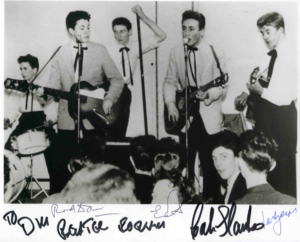 Just as William Orr and Roy Huggins were beginning a collaboration that would dominate TV and Jack Kirby was beginning a collaborative pairing with Stan Lee that would shake the world of comics, in a small church in England a pair of teenagers were meeting whose partnership would transform not just music, but culture itself. A Liverpool England lad, John Lennon had formed a small skiffle band called the Quarrymen in 1956. While performing at St. Peter’s Church in Liverpool, John Lennon and Paul McCartney met and the pair found out that they have similar pop idol interests: “Paul, what kind of music do you like?” asked John. “Well I used to like Lonnie Donnegan but now that skiffle is fading out I love the music of Elvis Presley, Eddie Cochrane, Gene Vincent, Little Richard…”
Just as William Orr and Roy Huggins were beginning a collaboration that would dominate TV and Jack Kirby was beginning a collaborative pairing with Stan Lee that would shake the world of comics, in a small church in England a pair of teenagers were meeting whose partnership would transform not just music, but culture itself. A Liverpool England lad, John Lennon had formed a small skiffle band called the Quarrymen in 1956. While performing at St. Peter’s Church in Liverpool, John Lennon and Paul McCartney met and the pair found out that they have similar pop idol interests: “Paul, what kind of music do you like?” asked John. “Well I used to like Lonnie Donnegan but now that skiffle is fading out I love the music of Elvis Presley, Eddie Cochrane, Gene Vincent, Little Richard…”
Hey! John interrupted, “they’re all the people I’m into.”
Joe Simon was still restless, editing at Harvey and Prize was not the same as creating and selling new concepts. He and Jack had been working on a new idea while still at Mainline. The concept was an updated kid gang book, where the kids were now adults. A group of four specialists who sought danger and thrills no one else would face. Jack and Joe put together a presentation for Challengers of the Unknown and probably reluctantly due to their break-up with DC just after the war, took it to National Publications. In July 1956, they made the presentation to Editor Jack Schiff, a familiar face from their earlier time at DC. Jack Schiff liked the presentation, but things had changed at DC. They were no longer allowing outside studios to supply work; all books were tightly controlled by its editors. So Joe Simon would not be allowed to control their new title. With no other duties except perhaps as inker, Joe decided to pass on the project. Jack was perfectly happy to pencil the book for page rate since DC paid the highest rates in the industry. Joe went back to work at Harvey. His attempt at restarting Simon and Kirby failed. Jack Schiff partnered Kirby with writer Dave Wood.
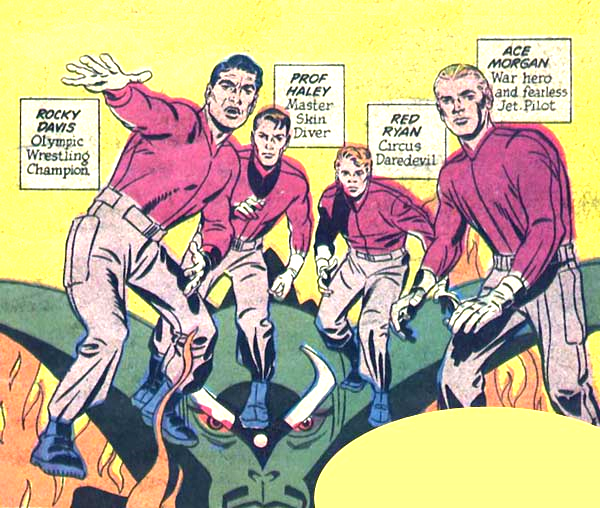
The fearless Foursome
The Challengers was unique, most groups were formed by force fitting existing heroes into a working unit to take on a powerful enemy, a la Justice Society of America, but the Challs were neither drafted, nor brought together to save the world. The Challs became a group as an act of fate, a singular moment in time, a shared unexpected happening that changed their lives and forged a unit. While flying to a radio interview, the four adventurers are blown off course by a fierce storm. Ace Morgan was a test pilot, Red Ryan a circus daredevil, Prof. Haley an Undersea Explorer, and Rocky Davis was an Olympic wrestler. Unable to control the plane, pilot Ace Morgan crash lands the plane in a dark forest. One by one from the wreckage the four men emerge, unscathed. Red says, “We should be dead–but we’re not! My watch should be smashed. yet it’s unharmed-keeping time” Ace replies; “Borrowed time, Red, we’re living on borrowed time.” Realizing that they have faced down death itself, the men decide to band together and take up any challenge that is too scary for normal people. Taking jobs for men who “fear neither devil, nor death”
The new book was scheduled to appear in a tryout series named Showcase. Showcase was started as a way to introduce new concepts and see what the audience response would be. If warranted, the title would receive its own series. The public little noted the first 3 issues, but for issue #4, National decided to reboot a long dormant super hero. The new Flash was the first of a flood of new and rebooted super-heroes. DC had reignited the super-hero craze.
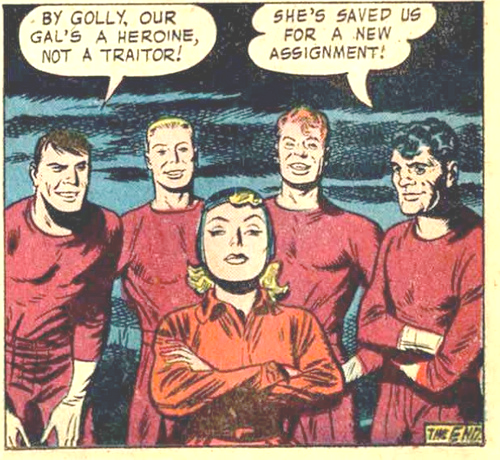
Enter the fifth Challenger
Challenger’s appeared in issue #6, and again in #7, a sure sign that Schiff was excited with the series, ordering a second issue before the first even hit the stand.
The adventures thrown at the Challs rivaled any ever seen in comics. They faced every scary nightmare from the occult to futuristic technology. Sorcerers, aliens, sentient robots, ex-Nazis, even giant rocky mythological warriors, and the League of Death Cheaters never flinched in their duties. There were times when they separated and worked independently and then there were times when the worked together as a tight knit unit. In the second issue they even had outside help as a beautiful computer expert joined the group. June Robbins would become the unofficial fifth Challenger when she was recruited to help defeat Ultivac, a sentient robot created when “the use of radioactive materials in building this machine has somehow developed in its braincase …a thinking process on a par with humans!” One of the unique factors in Challs was that along with the futuristic elements, actual recent scientific developments were included. When Rocky is accidentally shot it is left to the doctors to perform a new process of open heart massage to revive him. The robot seeking sentience and acceptance was a concept Jack would revisit numerous times.
Go into space, crash land, get power to flame on – Romance comes full circle
The art is primo Kirby, powerful, detailed and imaginative. The strange part is the formatting. Harking back to the early 1940’s, the pages are full of the large circular panels and zigzag borders. This was also seen in some of the concurrent Yellow Claw stories and a few DC fantasy tales. The inking in the Challs books was very clean, most likely due to the inking being done by DC stalwarts like Marvin Stein, George Klein and Bruno Premiani. It’s hard to know what editorial demands led to this cleaner, white bread inking. What is missing is the circular shadows, and halos and claustrophobic geometrics. There are a few in the first issue, but none later. This may have been more a Joe Simon technique. The inking on the Yellow Claw stories is dense, full of heavy cross-hatching and the heavy shading of the Simon and Kirby studios-minus the circular shadows and arches. The Yellow Claw pages were probably inked by Kirby himself. Schiff’s instincts were good; the response was positive. He assigned Kirby to do 2 more issues for Showcase # 11 &12.
We will see stone heads and Rocs again
Schiff also assigned Kirby assorted back up stories for National’s fantasy titles. These were similar in theme to the sci-fi fantasy tales that Jack was doing at Atlas for Yellow Claw, concepts like thought control, size shifting, alien visitations, and interdimensional travel, Kirby finally found the genre he was born for.
OK not every monster was a hit – Krackel, krackel, krackel
Jack had rebounded once again, he was back doing steady work for three companies, yet the industry was still in turmoil. Martin Goodman, a seasoned businessman was about to make a big mistake-one that would almost cost him his comic business. In a move with strong similarities to what happened to Mainline, Goodman developed distributor problems.
At the beginning of the decade, several events occurred at Atlas that would have long term results. Perhaps most important was that Goodman summarily fired his large bullpen of artists; instead they would now be considered “freelancers’ who were considered independent contractors responsible for their own taxes, own materials, own vacations, yet have no attachment to their work as the company claimed all rights to their creations. Despite this separation between them and the editor, Stan would keep up the fallacy of a close knit group of friends. Second, Martin Goodman had secured his news stand position by becoming his own distributor. He called it Atlas News Company and made his 50-80 comics a month the core of the company as well as his paperback and magazine divisions. The Atlas insignia became the one uniting feature of the company.
In 1956, in a questionable decision he suddenly and inexplicably dropped Atlas News and joined the largest national distributor American News. American had become prominent because of its 3 tier set-up. The main distribution, a series of sub-distributors covering the country, and a web of retail stores that sold to the public. But all the distributors were suffering from the effects of the Kefauver hearings. Publishers, retailers and readers had been falling by the wayside for the last couple years leaving the national distributors in a tenuous position. Horror struck when in early 1957, American was hit by both the government and customers and was forced to close shop. Dell, its largest client canceled its service and followed with an anti-trust suit over the monopolistic nature of the company, which it says failed to maximize Dell’s place in the market.
Goodman was suddenly left without a distributor and in what has been called “the 1957 Implosion” he closed down the shop and stopped buying new product. Stan Lee had the sad job of telling his friends that there was no more work. John Romita was asked to bring in his unfinished story sans pay, and was told he was laid off by a secretary because Stan was too embarrassed to face him directly.
Goodman quickly scrambled and worked out an agreement with Independent, the distributing arm of National Publications. Goodman sadly accepted the new conditions that forced the closure of the paperback division, and limited his comic output to 8 titles monthly. For the short term, Stan would take the back inventory from upwards of 80 titles and force them into 16 bland bi-monthly books.
Goodman’s empire overnight became one of the smallest comic publishers.
For all the sordid details, try to pick up a copy of Tales of the Atlas Implosion, self-published by Dr. Tom Lammers.
Classy John Severin cover – cute little fishies
Jack had just finished the first issue of a new series for Stan Lee, The Black Rider Rides Again and started on the second issue when word came down that work was halted. Atlas was shut down. Once again outside pressures set Kirby back. The industry was taking a battering, and the artists were the casualties.
Things looked up somewhat when Frank Giacoia asked Jack to ghost his newspaper strip Johnny Reb and Billy Yank. For the next seven months –from July 1957 to Feb. 1958–Jack did the Sunday strip. Kirby also collaborated on several proposed newspaper strips with Frank Giacoia, Marvin Stein, and Will Elder. Rumor has it that Giacoia offered Kirby the work due to the falling out at Atlas. It looked like Kirby may have colored some of them. Over at DC, Jack Schiff increased the page count on his mystery books and offered Jack the Green Arrow strip when George Papp left.
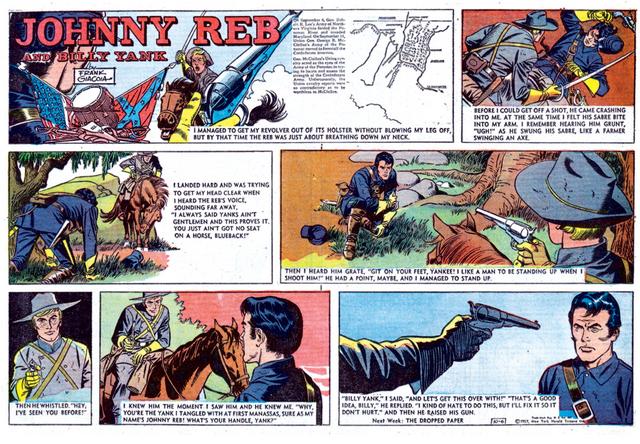
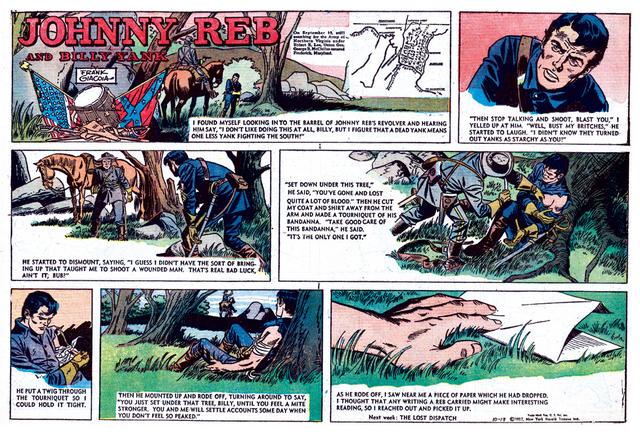
Kirby aping Giacoia
Some more good news came when Joe Simon contacted Jack about some new work for Harvey. Harvey must have noticed the good response that DC was having with their Post-Atomic fantasy books, and decided to update one of his horror titles.
Kirby’s time at Prize in the late 50’s is challenging. Most of the work seems to be Kirby simply providing pencils for Simon edited projects. Yet there are books which claim that Joe Simon and Jack Kirby were both editors, and oddly enough, show very little Kirby work. One such is All For Love, a romance book totally separate from Young Romance or the others. In fact, the only issue featuring Kirby work was (Vol. 3#2 Aug. 1959); very late in Jack’s Prize tenure. Yet the other artists seem to have been culled from the Simon/Kirby studio of a year earlier. It’s hard to know just how accurate these credits are, but the ownership blurbs were supposedly notarized and verifiable.
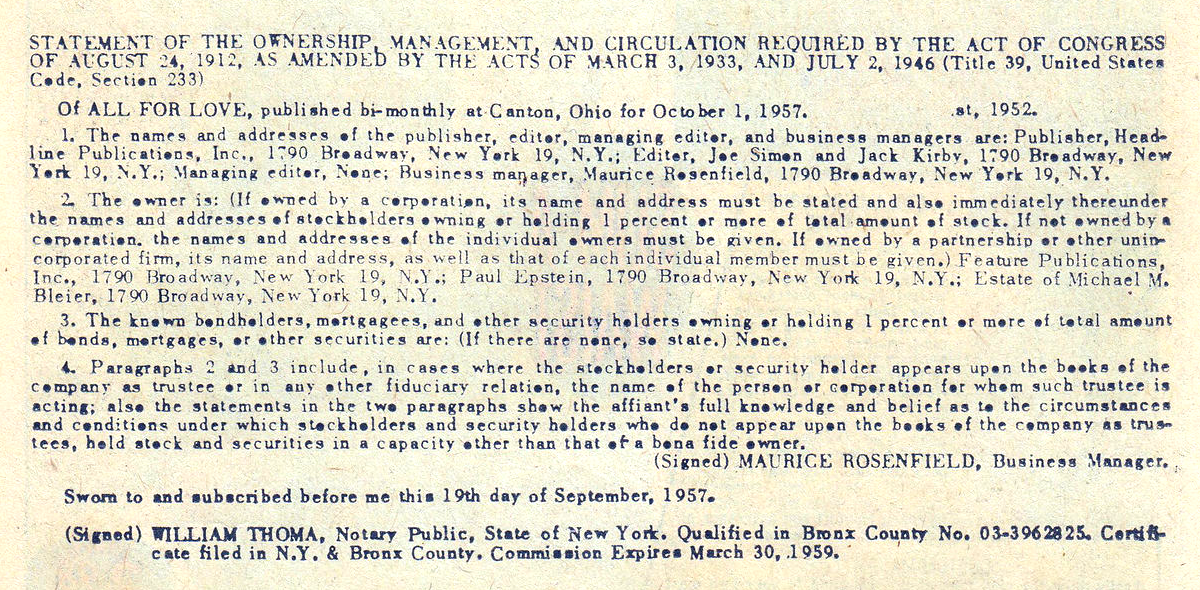
Funny that Young Romance and Young Love no longer had Kirby as editor. Joe Simon would always move in and out of Prize’s editorial chain, even up to the 1960’s, but the credit of Jack Kirby was rarely listed. S&K expert Harry Mendryk speculates that the listing of Kirby as editor on a couple series was a mistake. He points to what he thinks are corrective statements just a few months later, rather than waiting till the next year as was the usual method. He believes Kirby was just a freelance contributor by that time. But I still wonder. Why would Prize mistakenly credit Kirby on a long running series. The listing of Simon and Kirby was not an oversight, since neither was involved in the creation, but rather a specific choice by someone.
What is obvious is that Kirby’s Prize stories were no longer inked by Joe or another S&K studio inker. These stories are rather austere and lacking of crossshatching and the arches, and halos most common during the S&K years. It has been suggested that Jack inked many of these himself; though I still see a couple different inkers at work.
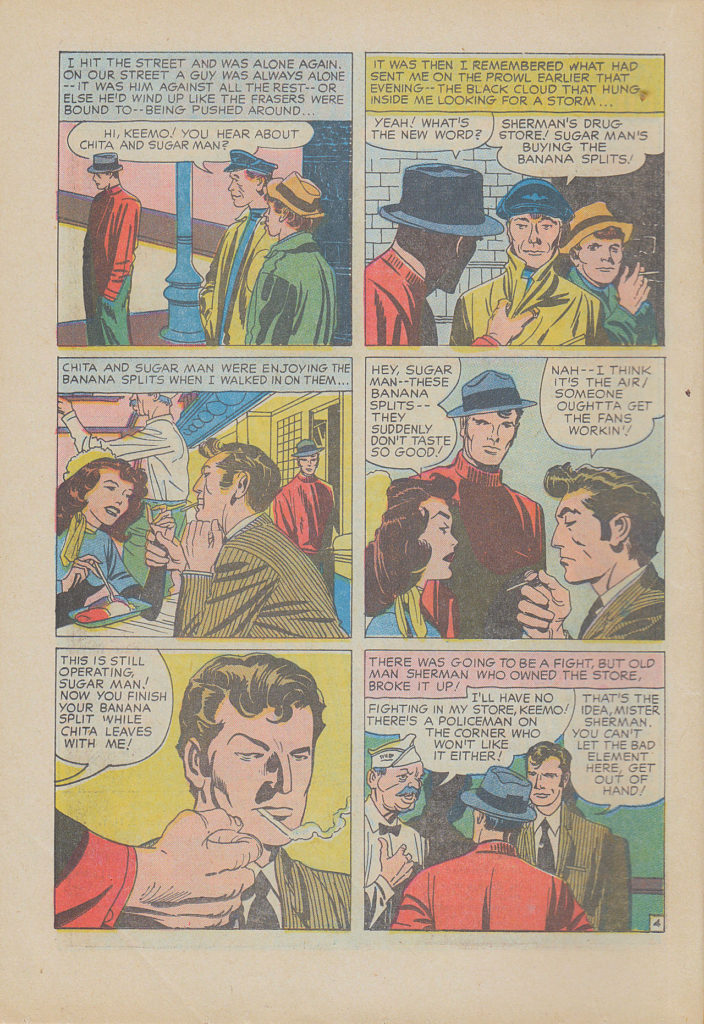
Inking is more planar and sloppy, lacking in depth and texture faces
more formulaic no snaky shadows, or arches
Back at Harvey, Black Cat had started life as Black Cat Comics – a vehicle for their popular female costumed heroine. When super heroes started to fade, the genre changed, first to a western title and then to a horror/suspense title. With issue #58 (Apr. 56) it entered the modern age with four stories by Kirby, all post-atomic sci-fi themed with the usual collection of aliens, mutates, and mad scientists and a new title, Black Cat Mystery.
A new companion book soon joined. Alarming Tales #1, cover dated Sept. 1957 featured five Kirby stories with themes and plot elements that would reecho throughout the remainder of Jack’s work. The first four issues of this series represent perhaps the most seminal period of Kirby’s later career. Plus for perhaps the first time, Kirby’s work received an illustrative finish to his pencils when Al Willianson brought his Raymondesque sensitivity to the inking. Williamson had a softer more textured line than any inker over Kirby before, and the result over Kirby’s powerful pencils was astonishingly beautiful; a veneer of subtlety and natural lighting with an organic decorative sheen. Reminiscent of Hal Foster’s naturalness and texture, with Alex Raymond’s precision and grace. Al Williamson remembers; “I remember going up to Harvey and getting work there. They said” We haven’t got any work for you, but we have some stories here that Jack penciled. Do you want to ink them? I’d never really inked anybody else before, but I said, “Sure, because I looked at the stuff and thought, “I can follow this. It’s all there.” I inked it. They liked it, and gave me three or four stories to do.”
Joe edits seminal Kirby
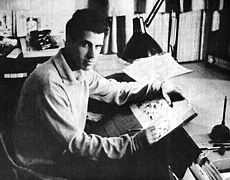
Al Williamson inks
On Oct. 4 1957 sci-fi, technology, and Cold War socio-politics collided when the USSR launched Sputnik All eyes were now focused clearly at the skies, and a National purpose was ignited. Joe Simon or Al Harvey realized the importance and immediately assembled a new title. Race for the Moon #1 was rushed out in only 2 months. The Kirby cover was a lie, inside contained reprints of space themed stories culled from Harvey’s archives, mostly by Bob Powell. More interestingly is that the Kirby cover was blurbed in just about every Harvey book, yet the actual cover was changed from the blurb sample. The background world covered 2/3rds of the background on the cover blurbs, but the actual cover shows that the editor, possibly Joe Simon shrunk the background world to a small corner of the cover—perhaps to make the figures stand out stronger. This actually happened regularly as editors continued to make changes up to the last moment. Issues #2-3 contained all new stories by Kirby, centered on space exploration, national paranoia, and alien contact. Simon and Kirby also introduced a new team.
What Sputnik wrought
Following the template seen in Challengers of the Unknown, The Three Rocketeers featured Figures Faraday, an older scientist, Kip McCoy, a fearless pilot leader, and Beefy Brown, a brawny earthy engineer. All that was missing was a young hothead. Jack also mindful of the impact of Sputnik, had recruited Dave Wood, the writer from DC to work up a space based strip for newspaper syndication. The result was called Space Busters, inked by Marvin Stein. There was another unused strip called Surf Hunter with an incredible combination of Jack Kirby and Wally Wood.
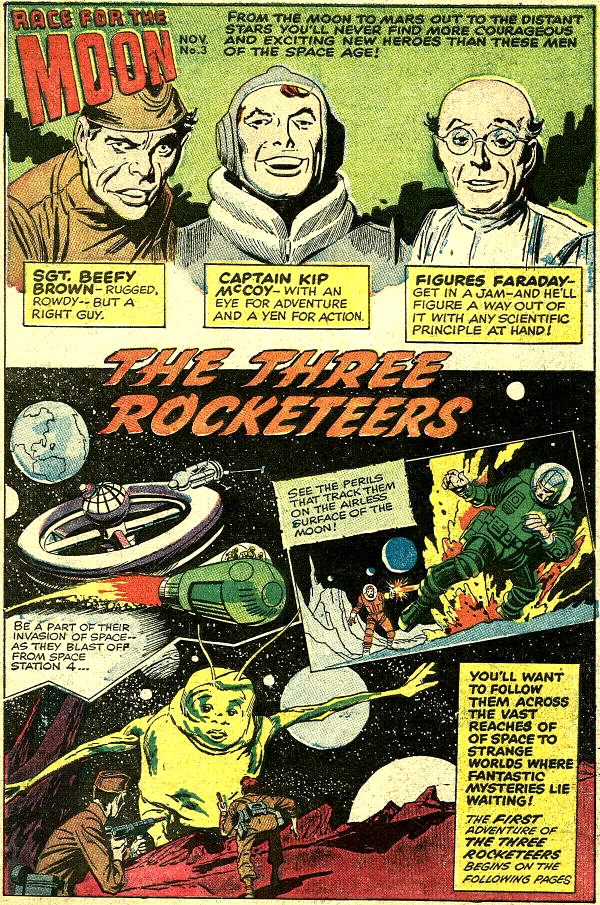
Another Kirby group template
Kirby surrealistics – not of this world
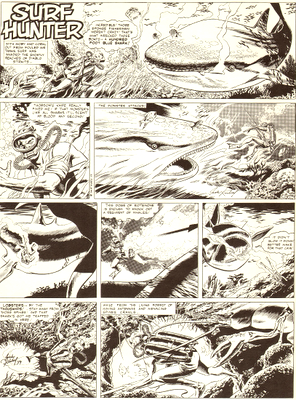
Proposed Kirby strip w/Wood
While this was going on, word came down that Challengers of the Unknown was such a success that it was being given its own title. This was the first of the original Showcase features to get the gold ring, even before the resurgent super-heroes. The other editors were working overtime to come up with their own fearless adventure team. The Suicide Squad, Rip Hunter, Sea Devils, all followed the template forged by the Challs. DC had a new hit, and a new genre and Kirby gave it to them.
Joe was not the only one taking notice of the space race. In Jan. 1958, Harry Elmlark walked into the offices of National Periodicals. Harry Elmlark was a sales representative for George Matthew Adams Service, a syndicate house. He was looking for a space based strip that he could sell to the newspapers. He met with Jack Schiff, who showed him several concepts, but Elmlark wasn’t thrilled. Schiff suggested that he might be able to come up with something, and asked Elmlark for a couple days. Schiff went to Jack Liebowitz, General Manager of DC and told him about Elmlark’s request. Liebowitz explained that he had no interest in DC getting involved, but if Schiff wanted to pursue it on his own, he was welcome to try.
Jack Schiff then approached writer Dave Wood, Schiff had remembered that Dave had told him that he and Jack Kirby were working on a space strip concept. After being told of Elmlark’s request, Dave said that he would retrieve the samples and meet up with Schiff the next day.
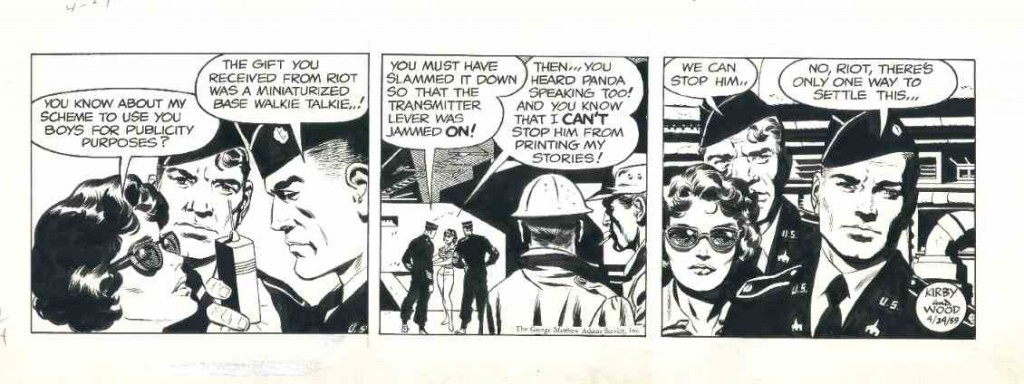
Dave brought the samples to a Kirby strip entitled Space Busters, while not sure if Elmlark would be happy with the strip, Schiff discussed some story ideas and told Wood that he would show the samples to Elmlark. Later that day, Elmlark met up with Jack Schiff, and presented the samples. He liked the art, but wanted a stronger storyline. He said he was in a hurry as there was another artist’s work in the running.
Schiff met up with Wood and Kirby and they all agreed to take a crack at the strip, with Schiff supervising the script with Wood with Kirby drawing it. Dave Wood went home and along with his brother Dick, worked on an outline and brought it back to Jack Schiff. But Schiff was tied up with other business, he contacted Elmlark and explained that he wasn’t going to be able to do the feature, but would send Wood and Kirby to work directly with him.
Kirby and Wood met up with Elmlark, shared the sample strips, and listened to his ideas. The meeting went well. Wood would finish a script based on their shared ideas and Kirby would prepare new art immediately. Elmlark was heading out of town soon. The samples were soon done; Schiff liked what he saw and turned them over to Elmlark. Elmlark accepted the samples and took them on the road to sell the concept.
The Wood Brothers and Kirby started discussing a proposed contract, and part of the agreement was a 5% finder’s fee for Jack Schiff for his part of the deal. Word came back from Elmlark that he thought he had the concept sold. Negotiations and a binder agreement with the syndicate were drawn up on Feb. 10th, with no mention of Jack Schiff. The negotiations with the syndicate did not quite go to Jack Kirby’s satisfaction. It seemed that too much of the actual production cost of the strip was being placed on Kirby’s end, so the Woods and Kirby renegotiated their contract. Their talks broke down when they couldn’t work out an equitable percentage. Kirby decided to walk.
Later that day Kirby met with Schiff and they discussed Kirby’s reluctance. Schiff tried to reassure Kirby that it was silly to walk away now after his hard work. The next day, Kirby and the Woods met again and ironed out a new contract, this time with a higher split for Kirby, who had to pay for an inker, and letterer, plus supplies. They explained to Schiff that Kirby suggested lowering Schiff’s percentage to 3%, and they cut the difference and decided it would be 4%. Schiff agreed and said let there be no more disputes. They met up later and Schiff suggested they memorialize the agreement. Dave Wood and Kirby signed a letter of intent agreeing that Schiff would be paid 4% for his role.
That’s Jack Schiff’s story. For Kirby’s part he differs in some areas. Kirby was excited about getting a newspaper strip; it was every comic artists dream. But from the very first negotiations, Jack was upset. It seemed everyone wanted a piece of the action. Elmlark was getting it from the top, Wood and Kirby would split the remainder, with most of the expenses coming from Jack’s share. Then Jack Schiff chimed in, he wanted a cut also. Jack didn’t believe that he deserved a share, certainly not an ongoing percentage-possibly a one-time finder’s fee- but nothing more. To Kirby’s way of thinking, Schiff had dropped out of the deal when he turned the negotiations over to the Woods and Kirby, plus it was a Kirby drawn sample, done prior to Elmlark and Schiff, that they had used as a pitching point. It was Dave Wood and Kirby who closed the deal. Schiff was not involved with negotiations on a contract with the syndicate. None of the expected jobs of an agent were done by Schiff. Nothing of the deal was due to Schiff, except for passing along a phone number. Memories of Reese Rosenfield probably clouded Jack’s judgment.
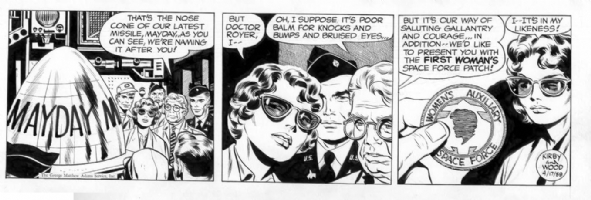
Wally Wood loved drawing the ladies – Kirby’s best femme fatale
Kirby and the Wood Bros. worked on a contract and Dave suggested a gratuity for Jack Schiff. When Schiff heard, he refused a one time offer and demanded a percentage. When told of this, Kirby balked at giving Schiff a cut. Dave Wood said “If we don’t give him a percentage, he’ll be furious with you and maybe with me.” Kirby understood a shakedown when he heard it. His Lower East Side hackles rose up. The idea being that Schiff controlled the assignments for DC, and might cut them back. Jack understood the situation and relented. On April 15th, Kirby and Dave Wood met with Schiff and according to Kirby, Schiff made it obvious that there would be repercussions if Kirby didn’t agree. Schiff typed up a letter of intent and Dave Wood and Jack Kirby signed — Kirby reluctantly. Interestingly, Jack Schiff never signed-anything!
For most of the summer, things were going well. Production on the new strip Sky Masters was proceeding well. Unbelievably, Kirby was able to hire Wallace Wood to ink the strip. Wally Wood was a breath of fresh air that wafted in from the American Mid-West, cocky, restless, and talented. His work was imbued with all the right inspirations; he loved the cartoonists like Hal Foster, Roy Crane. Alex Raymond, and Milton Caniff, but also studied the new masters, like the elegant Lou Fine, and the energetic and dynamic Jack Kirby. He started in the early 1950’s, mostly with the small netherlands of American publishers like Fox, and Avon. He quickly graduated up to EC Comics, where Bill Gaines set him to work on his newly fashioned comics line. Wally produced work for almost all of Gaines titles; the romance, the war and mostly the sci-fi strips. Wally was so adept that he also worked on Mad Magazine doing parodies and caricature. When Gaines closed down the comics in 1956, Wally became one of the major artists on Mad Magazine. He also picked up some work providing covers for sci-fi mags like If, and Galaxy. Wally; both solely and partnered with Joe Orlando had created a body of work unequaled in the 1950’s. Wally was considered a penciler supreme.
He had come along and spearheaded the next great grouping of comic artists, Along with Don Heck, Dick Ayers, Steve Ditko, and Al Williamson, et al. he ushered in the second wave of creative talent to the comic world. It was this supreme group that would partner with Jack Kirby to supply the Silver Age of Comics. It’s unknown just how Wally became available, and why Kirby would ever even consider him. It had been a long time since Wally inked other’s work. But it was a match made in comic heaven. Just as Al Williamson had brought an extra dimension with his soft textured inking, Wally Wood brought a talent for sharp as a knife, hi contrast, hyper dramatic inks. It was hard as diamonds, and gave the strip the depth and feeling of isolation and hi-contrast needed for a space based strip. All the surfaces became shiny and reflective with a feeling of artificial light throwing hard and sharp shadows, the perfect ambiance for the hi-tech claustrophobic life in deep space. As to how– the only reference was from Tatjana Wood who recalls Jack Kirby coming to the house and asking Wally to assist him. Why Kirby assumed a penciler of Wally’s talents would agree to ink a strip also remains a mystery. It may have been as simple as economics. The late 50’s were a horrible time for comic artists. With little work they searched other avenues. After producing 4 covers on a book series, Wally lamented “It’s not comic books, but it pays the bills.
Sky Master’s was different; it wasn’t an Alex Raymond space opera. The focus wasn’t on some futuristic world of alien societies or ray gun toting space western. It was set in the near future, with the modern technology of the nascent space race. It starts with man’s first attempt at space flight. The main draw was the attention to detail and the accuracy of NASA’s technology. These were real rockets, and existing space capsules, not the space darts of Buck Rogers, or Flash Gordon. It was immediate; the stories were taken from the daily headlines. The sub-orbital flights of Shepard and Grissom–the use of animals rather than humans, and fear of cosmic rays. The cast of characters fit the Kirby pattern. The brave laconic pilot hero,(Sky Masters) the science mentor, (Dr. Royer) and (Will Riot) the beefy Earthy mechanic sidekick, and friend from the Korean War and the quiet girl friend (Holly Martin) daughter of a senior pilot that Sky rescued, and her hot headed younger brother Danny. This strange mix of sci-fi and sci-fact was magical, Kirby bridging the ground and the stars, Wood supplying the texture and. ambience.
Kirby quickly brought in an active female presence in Challengers with June, a computer wizard who assisted the boys in Showcase #7. In Sky Masters, Kirby introduced perhaps his most sexual, animalistic, and driven female protagonist when he introduced Mayday Shannon- an ex-girlfriend of Sky’s and renewed rival for Sky’s affection.
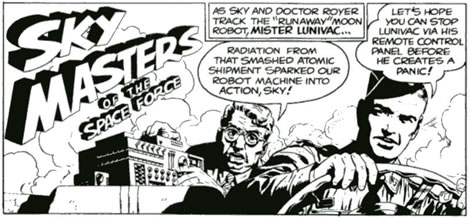
Another radiation affected machine
This relationship was right out of a Simon and Kirby romance story. Mayday is Sky’s equal in every way and the perfect foil for his stodgy, straight assed, uptight military bearing, and no one inked more beautiful woman than Wally Wood. The training scenes are so realistic, due to the fact that Kirby was getting data and photos directly from NASA. Kirby said that NASA even invited him down to Cape Canaveral to experience the actual training program, and to witness flights. Neal Kirby, who loved airplanes and flying as much as his dad, used to look forward with great anticipation the manila folders sent to Jack by NASA.
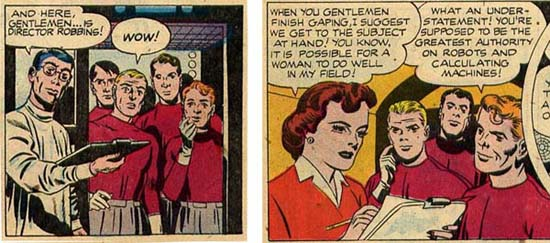
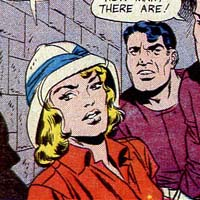
Jack quickly added June Robbins. Wally Wood made her blond and gorgeous
Work at DC continued unabated. Challs got better and better. A back-up strip, Green Arrow became available when the penciler, George Papp was moved to a different book. Jack Kirby took over the strip in both Adventure Comics and World’s Finest Comics. Like most of the other DC super-heroes, Green Arrow was being updated, and Kirby supplied the updated origin story. And like every other Kirby title, it became a showcase for every wild sci-fi concept he could think of; alien Green Arrows transporting to Earth, time travel, hypnosis and gadget arrows a-plenty. But there was some blowback from other DC editors who thought the changes on Green Arrow were hurting the book. They went to Schiff and had him make Kirby revert back to the earlier simpler tales.
Thor’s hammer escapes from Journey Into Mystery – Green Arrow meets Kirby wrong one talking
Shortly, Wally Wood also became the inker for Challengers as of issue #4 and the book never looked so well. This accounted for Wally reaching a pinnacle. It was always a goal of comic book artists to get a gig at DC. They paid the highest, they sold the best and working there carried a cache of success in the business. Wally’s work for DC would be hit and miss, but this job was a good start. It also introduced Wally Wood—the inker extraordinaire –to the business, a job that Wally would do for the rest of his life. Interestingly, Jack inked many of the fantasy stories and Green Arrows himself. Roz would help out outlining the pencils in ink, and filling in the black areas. The extra money for inking was nice.
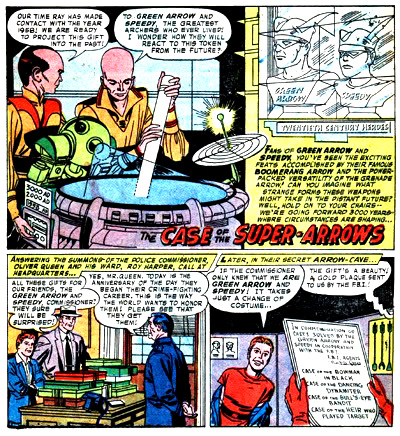
Green Arrow meets Kirby sci-fi
Jack was so into the project that once he met up with Wally at his house and saw Al Williamson—the soft illustrative inker from before at Harvey– working in the studio, and Jack recoiled in horror. Al recalled; “Wally told me later. He’s worried that you might be inking his stuff. I told him, “Don’t worry, he’s a good artist, but he’s not gonna touch this. Wally was a good guy, but Jack was a little concerned: What’s this guy doing here?” And he scared me. You don’t wanna mess with Jack!”
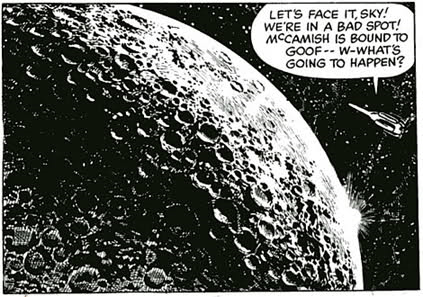
Eat your heart out Vince Colletta—Wally Wood
In June, 1958, Jack Kirby got a call from Stan Lee. The inventoried art that they had been printing during the Atlas implosion was running out. Martin Goodman gave him the green light to buy new art. The reduced output had been a mixture of romance, war, teen humor and old fashioned gothic horror. Incredibly, Stan’s favorite collaborator, Joe Maneely had died just a week before when he fell between train cars on the way home. With the new work, there is a sudden shift to the Post-Atomic sci-fi genre Kirby had been doing for the past year. Within one cycle a full 6 titles had been transformed into the new genre. Jack quickly became the #1 artist and the cover artist for Stan’s adventure books. Stan promised Kirby as many pages as he could provide. Steve Ditko became the de-facto #2. Wally Wood evened helped out inking a job- or maybe it was left over inventory from DC. Strangely, it fell to inker George Roussos to see the books and tell Jack and Stan that they had hit on something good. Stan muttered, “I’ll believe you when I see the sales figures.” The sales on the fantasy books leapt to the top of Atlas’ charts, they led the teen and romance books by 20%
At the same time, the two Liverpool moptops paid a local recorder to make a vanity pressing of the Quarrymen. Given to close friends, only a couple copies of this pressing remain. It contains the first recorded song by Paul McCartney and George Harrison on the back.
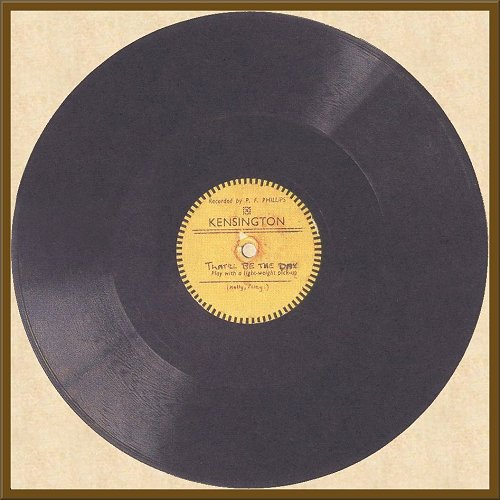
The earliest known recording of the Quarrymen on a vanity label doing Buddy Holly (1958)
The genius of Joe Maneely passed too soon – George “Inky” Roussos
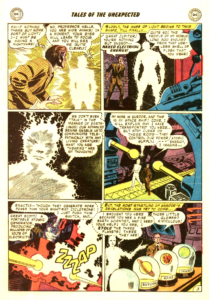 In August, Sky Masters was just about to go to press. The strip looked great and all the work Kirby put into it showed on the strip. There had been some rumblings from Jack Schiff. Schiff approached Kirby and talked about renegotiating their verbal agreement for 4%. (The letter of intent was not a contract) According to Kirby, Schiff wanted a bigger piece, perhaps as much as a 10% sliding fee. Kirby was furious, he balked at original 4% because he didn’t believe that Schiff had done anything other than bring DC Elmlark and Wood/Kirby together. It wasn’t a Schiff sample that sold the strip. Schiff didn’t assist on the writing or art chores. Kirby said that Schiff made reference to his work at DC and how it might disappear if he didn’t cooperate. Kirby says it wasn’t done verbally, but with a wink and a nudge, as most strong arming is done. Kirby stood his ground, and in fact implied he might not even pay the 4%. The meeting ended with both sides upset, and still no signed agreement.
In August, Sky Masters was just about to go to press. The strip looked great and all the work Kirby put into it showed on the strip. There had been some rumblings from Jack Schiff. Schiff approached Kirby and talked about renegotiating their verbal agreement for 4%. (The letter of intent was not a contract) According to Kirby, Schiff wanted a bigger piece, perhaps as much as a 10% sliding fee. Kirby was furious, he balked at original 4% because he didn’t believe that Schiff had done anything other than bring DC Elmlark and Wood/Kirby together. It wasn’t a Schiff sample that sold the strip. Schiff didn’t assist on the writing or art chores. Kirby said that Schiff made reference to his work at DC and how it might disappear if he didn’t cooperate. Kirby says it wasn’t done verbally, but with a wink and a nudge, as most strong arming is done. Kirby stood his ground, and in fact implied he might not even pay the 4%. The meeting ended with both sides upset, and still no signed agreement.
In late August tragedy struck. Dick and Dave Wood had a third brother, Bob Wood, a well respected artist who worked for years on Lev Gleason’s Crime Does Not Pay. Gleason’s comic company was another casualty of the Comic Code Authority and Wood found work harder and harder to find. Bob Wood took to drinking and occasional work for sleazy magazines doing porno. On Aug 27th Bob was arrested for the grisly murder of his girlfriend. In a drunken rage, Wood battered the woman with an electric iron when she began pressuring him about marriage. Bob Wood would plead guilty to manslaughter and was sent to prison for several years. During this period the Wood Bros. became more and more distant. Constant attempts by Kirby to contact them were rebuked or channeled through the mother. Soon, all communications ended and Kirby took on the role of writer as well. Sky Masters finally saw print on Sept. 8, 1958 to great reviews. When sent their first checks, Dave and Dick Wood sent Jack Schiff the promised 4%. Kirby, true to his word, withheld payment. Now it was Schiff who was furious, and true to his implication, Jack was taken off the Green Arrow strip, and the fill-in fantasy tales. This left Kirby with only Challengers of the Unknown
Kirby’s breakthrough classics DC take on post-war fantasy
During this period negotiations continued. At one meeting Kirby agreed to pay Schiff a one time $500 payment for setting up the original meeting. But Schiff would have none of that; he wanted a continuing source of income.
Still later, Schiff had a dinner meeting with Jack Kirby to try to end this stalemate. Kirby held to his position when Schiff changed the subject to Challengers. He claimed that Kirby had stolen some ideas from a Challengers story conference between Schiff and Wood and Kirby, and used it for Sky Masters and that he thought that Jack owed Schiff for the ideas. Schiff went so far as to draw up a contract on a napkin stating Kirby would pay Schiff for the ideas. Jack exploded! First Jack claims they never had any story conferences with Schiff on the Challengers, and even if they had, the dispute would be between Schiff and the writers, not Kirby, the artist.
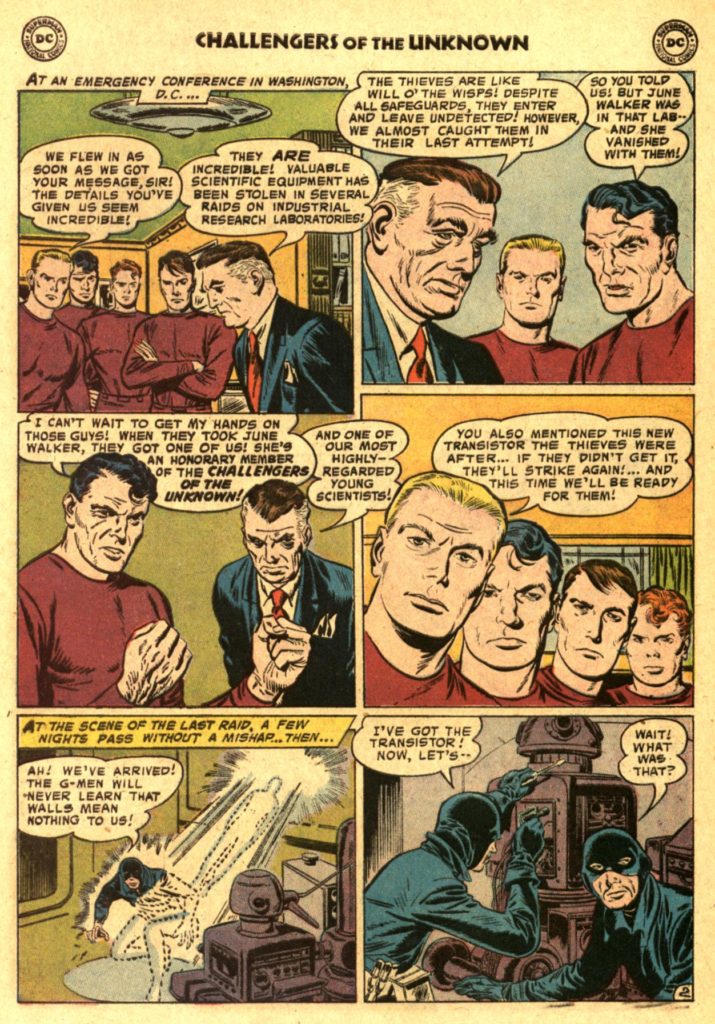
Masked villains, transistors, inter-dimensional travel and a kidnapped woman. Where’s the FF?
(this was still early in the process before the Woods began disappearing) Second, there is no evidence of shared work in the early Sky Masters and any Challengers story. This was a classic strongarm tactic. But Jack understood what Schiff was doing; he was laying the seeds for pulling Kirby off Challengers. If Kirby complained to Jack Liebowitz about losing the strip, Schiff had a cover my ass story. Shortly thereafter, Jack did lose the Challengers assignment. There was no repairing the riff. In Dec. 1958, Jack Schiff sued Jack Kirby for monies owed.
Kirby on top again
Looking back on his time on Challengers, Jack considers them a malleable venture, unfinished and evolving. “The issues I did were still formative and I can’t answer for what DC did with them. But they were heading for the super-hero image when I left. In many ways, they were the predecessors of the Fantastic Four.”
One interesting bit is that in Challs issue #9 the header reads “The Plot to Destroy Earth” with art by Bob Brown. In Jack’s files were unused pages to a Challs story called The Plot to Destroy Earth showing Kirby had started that issue when summarily told to stop. It’s obvious the breach wasn’t planned by Jack.
Jack was still doing Young Romance for Prize, and as agreed to by Stan Lee, his page count at Atlas continued to grow as he lost pages at DC. Jack was contributing stories to six fantasy titles, a couple westerns and now a war comic entitled Battle. The page rates were 2/3 of what DC paid, and going lower but the extra pages made up some of the difference. The fantasy books had fallen into a pattern. Gone were the gothic horror fantasies, replaced by Post nuclear BEMs. Jack Kirby would do the cover and the lead story, usually a 6-8 page monster story featuring a huge bug eyed alien or mutate trying to take over the world. This was followed by some more stories drawn by stalwarts like Don Heck, Paul Reinman, maybe Jack Davis or Joe Sinnott, and ended with a creepy Steve Ditko thriller. Steve Ditko was called back the same time as Jack and created a bookend duo for all times. As much work as Stan Lee could give him, Jack still had time to spare. Luckily sales had risen a few percent and Martin seemed happy.
Small titles added up
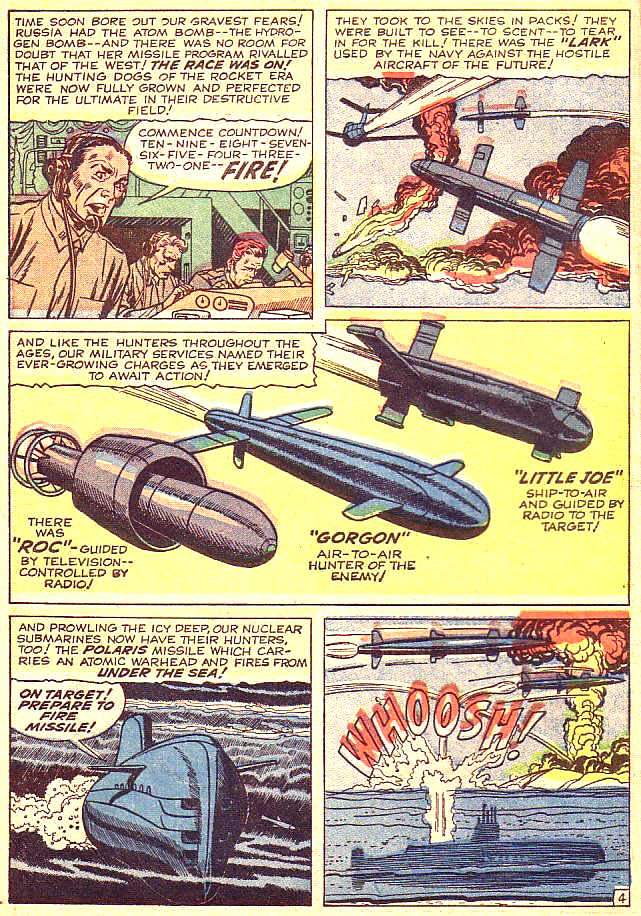
A little reality among the Atlas fantasy
In early 1959, Joe Simon got a call from John Goldwater, the head of Archie Comics. Goldwater had noticed the resurgence of superheroes over at DC, and asked Joe if he could package a couple new books for Archie. Archie had had some success at superheroes back in the forties with titles like the Shield, Hangman, and the Web, but had gotten out as the war ended. Joe told Goldwater that he would work on some ideas.
One of Joe’s first thoughts was of the shelved Silver Spider concept he had pitched Harvey in 1953. Another was an updated version of an old Golden Age character. This made sense since they were both reboots of previous Archie characters—the Web and the Shield.
The next day, Joe made a verbal pitch to Goldwater “A superhero who climbs straight up and down a building using a fine thread that he holsters in his costume like a fishing tackle.” Sounds like Night Fighter or the earlier Spiderman or the Web. The second book involved “an army private who did superhero chores in his spare time in a colorful red, white, and blue costume….Private Strong was….sort of like Captain America.” Goldwater liked both ideas and gave the go ahead for the two books on a regular schedule.
Jack and Joe together again
That night Joe called Jack Kirby. “Jack, I’m tired of the advertising game. We’re back in the superhero business.” Jack replied; “I thought superheroes were dead”’ “Not dead, just sleeping. We’re working on a new one. Come on over, let’s talk. It’ll be like Captain America again.” Joe answered. “A new superhero! Wow! What do you call him? Jack asked. “Spiderman.” Joe said.
It’s not sure if Kirby understood what Spiderman was, there’s some evidence that as early as the Mainline days that Joe had pulled out the old Silver Spider project and had reworked it into a character called Spiderman and even possibly evolving into the proposed Night Fighter; or if the idea of updating the Silver Spider was entirely new and Joe explained the idea of rebooting the old character. However it happened, Jack drew a new character- one with an origin gimmick copied from the Silver Spider- a young orphan finding a mystical ring and after rubbing it transforms into an adult superhero. The superhero aspect was all new, he now had spider like powers such as wall crawling, super-agility, super strength, uncanny extra senses that protected him from unseen dangers and gave him a vague awareness of trouble, plus a web shooter. These new powers were not found in the Silver Spider concept but several may have been borrowed from the Sid Jacobson memos. Jack drew up a couple stories.
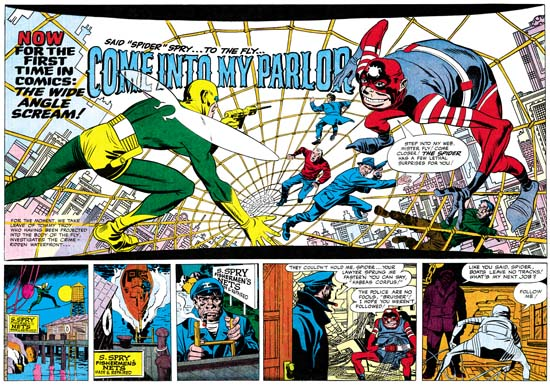
Double splashes again
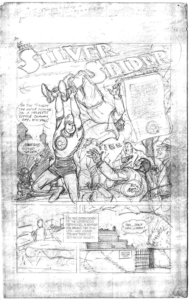
C C Beck’s first try
Somewhere along the line, John Goldwater made a decision to change the character from a spider to a fly. Spiderman was to become the Fly. Speculation is that this was in response to the popularity of the movie The Fly, starring Vincent Price, though it should be noted that in no sense of the word was the movie Fly considered as anything but a monstrous creature. Retconning that concept into a super-hero seems farfetched. Kirby’s first thought upon learning of the change was “A spiderman that walks straight up and down a building” If he’s a fly, why doesn’t he fly? Joe came up with a simple solution “So we’ll give him wings, small wings.” “Attached to his costume….the collar of his costume can be shaped like wings.” Joe told Kirby to “take it home and pencil it over in your immortal style.’ It should be noted that there was several different versions of the wings before it settled into an accepted style.
Jack reworked the idea into a fly, but it appears that Joe wasn’t totally satisfied. After getting the pages back, Joe swiped some Kirby poses from Stuntman and Fighting American and redid some panels. It is not known what the swiped panels covered up-perhaps some specific change in the costume not noticed by Kirby, but what is obvious is that nowhere does the Fly ever fly! Joe states; “except for a few minor details, like why would a fly fall from great heights because he was unbalanced by a bright light? And why does he climb up and down buildings when he should be flying like an honest fly? Neither of us bothered to change those silly problems. Who would notice them anyway?” In his bio, Joe points out a panel of the Fly falling and asks “Why doesn’t the Fly, fly? and answers; “Because he’s a spider.” Jack drew up a couple stories. Joe further explained to Will Murray; “Well, if you examine it carefully you’ll see that it was really the spider instead of the Fly. The Fly was originally the Silver Spider then it was taken to Marvel after we changed the name and became Spider-Man. One interesting quote from Joe highlights the transition. “Out went the web-pistol, The Fly now carried a buzz gun.” The problem with this is that the Silver Spider never had a web-pistol, so the only place a web-pistol could have appeared is from an intermediate character that had spider-like aspects.
Inventory pages finally used In Mainline ad: note blurb under Night Fighter title – where’s Foxhole?
Some of this scenario disagrees with Joe’s recorded version, but I believe this is more accurate than Joe’s often faulty reminiscences. J. David Spurlock, a respected historian agrees with my interpretation, he writes; ‘indicate (as my conversations with Jack did) that Jack updated the Silver Spider to Spiderman prior to switching him to the Fly.” Spurlock suggests that Jack was not brought into the process until it was being changed into the Fly-suggesting that Jack’s Spiderman was done at an earlier period, which might explain some of Joe’s confusion about just how and if Night Fighter fit into the overall picture.
Three inventoried Black Rider stories surfaced as filler stories in the Atlas western books, using up the material meant for Return of the Black Rider #2 pulled during the implosion. Found money.
The Double Life of Private Strong was unique. First the title referred to the hero’s alter ego, not his superhero moniker. The hero was called the Shield. The hero got his powers as a result of genetic engineering by his scientist father. When the father is being chased by Commie spies he flees and has a car accident. The child is thrown clear and found by a mid-western family and raised as their own. Now named Lancelot Strong, when he reaches his teen years the child finds the car remains and a costume. When Lancelot Strong donned the costume, it activated his super powers. He was invulnerable, could fly and had a radar sense that allowed him to see in the dark. When a typical Kirby Alien monster invades earth, the Shield jumps into action, during the fight Lances’ best friend is killed. Lance blames himself and his exuberance; he promises that he will be more responsible so that it would never happen again. A rather unique twist ending I have never seen before, but we would see again.
It’s hard to know just what inspires kids to get into comic art. In England at this time a youngster picked up a copy of this little remembered series, and the spark was lit. “The Double Life of Private Strong, which, incidentally, I had mis-remembered as The Private Life of Double Strong. Although some other hand was evident on the cover’s main figure, it was the background figures, and more-so, the vignette film-strip-like drawings by Kirby that framed the cover that caught my eye: I’d never seen figure drawing like that before, dynamic, fluid, highly romanticized. Kirby stunned me with that first issues interior work.” Barry Smith would draw on that Kirby inspiration years later.

Movie strip madness
Jack stayed on the two series for two issues. Private Strong was canceled after the second issue when DC complained that the hero was too close in several details to Superman. Joe would stay thru 4 issues of the Fly, when Goldwater decided he wanted to go in a different art direction. The strip continued for a few years. This was the last collaboration between Joe and Jack for approx. 15 years. It ended the greatest partnership in comic history.
Lancelot Strong – John Goldwater
Things seemed to be going well for Kirby at Atlas. Stan was giving him all the work he could. But behind the scenes, Martin Goodman was not happy. This wasn’t rare, according to Stan Lee, Goodman threatened to close down the comics division every other month. Sales were flat. In late 1959, while visiting Stan Lee at his office, Dick Ayers was told. “Dick, the sales of comic books are so bad—so bad that Martin Goodman, who is like an uncle to me, and is the publisher, doesn’t even say hello to me when he passes my office in the morning!” It’s like we’re on a ship that’s sinking.” “And like all the rats on the sinking ship—we have to leave.” We have to leave this business—quit drawing stories for comic books, Dick! Do something else!”
It should be noted that Dick Ayers was no fly-by-night artist, even during the implosion, Stan Lee had kept Dick Ayers working regularly on an ongoing strip. Something that artists like Joe Maneely, and Jack Kirby didn’t do. Dick took Stan at his word and got a job for the post office. Other artists, like Jack Davis, Al Williamson got no more assignments or refused the lower rates being offered, and inkers like Chris Rule were let go. Pencilers like Joe Sinnott, and Vince Colletta were downgraded to inkers. Atlas was experiencing another implosion. Kirby seemed not to be affected, the only difference was in the inking assignments, with Chris Rule gone pencilers like Dick Ayers, Don Heck, and Steve Ditko began inking over Kirby. Times were very tough. Though I doubt Steve Ditko was happy, it was always Stan Lee’s opinion that Steve Ditko turned out to be Kirby’s best inker. I find the results mixed, sometimes too heavy and sometimes just right.
Jack said that it was so bad that he went into Stan’s office and they were carting out furniture. Stan was distraught and told Kirby that Goodman was closing down the division. Kirby threw himself on Stan’s desk and wouldn’t let them take it. Kirby told Stan that he would go talk to Goodman and tell him that he personally guaranteed he would come up with new winners.
Most people assume that it’s one of Kirby’s embellished tales, but Atlas historian Jim Vadeboncour disagrees.
“I believe Kirby. Lee, who is still alive, is notorious for genial self-aggrandizing and Kirby’s story puts him in a bad light, just as it emphasizes Kirby’s creative role in the success that Marvel Comics was to realize. I take nothing away from Lee. His contributions channeled Jack’s energies as they’d never been before and magic happened. But, historically, left to his own devices, Lee has failed to create many lasting characters in his 20 years in the biz. Jack never seemed to run out of them”.
Kirby/Ayers the start of a long relationship
After a short hiatus, Stan contacted Dick Ayers to ask him if he would be willing to ink over Kirby’s monster stories. Dick agreed, but it seemed with every issue, the page rate decreased. Kirby liked Ayers inks. So did the readers who finally saw Kirby inked by a sympathetic hand. Chris Rule was the previous inker at Atlas, and his approach was way too timid for Kirby’s art. When Wally Wood left Sky Masters after a few months, Jack asked Dick Ayers to take over the job. While never matching Wood’s distinctive razor sharp sheen, Dick did an admirable job. He always suspected Jack and Stan Lee collaborated when it came to his payment for Sky Masters.
Kirby’s page count at Atlas continued to increase; he was now doing romance stories, war and back-up western tales other artists had been doing. Stan was mining Kirby for everything he could. Once Kirby started doing romance titles for Atlas, Prize Comics dropped him from Young Romance. With Young Romance #103, (Dec. 1959) his 13 year connection with Crestwood came to an end.
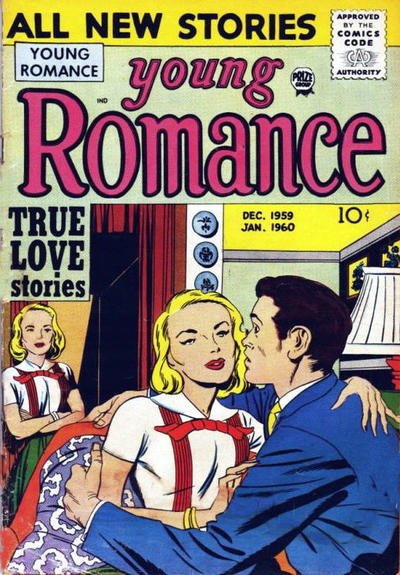
Jack’s last work for Prize
On October 16, 1959, the lawsuit with Jack Schiff came to trial. By all accounts, Kirby was a bad witness, stammering and stuttering incoherently in a combative manner. On December 3, 1959 the judge passed judgment. The judge had only two things to consider. Was there a legal contract, and was there any legal reason to void the contract. The first question was answered when the judge allowed the “letter of intent’ signed by Kirby and Dave Wood to stand as a legal agreement. As to the second question, the judge made clear that Kirby did not offer any tangible evidence of Schiff doing anything to void the contract. Though noting that the deal might have been an onerous one for Kirby, the judge had to rule in Schiff’s favor.
There is no evidence that Jack Schiff was anything but an honorable man, in fact there are several accounts of him being one of the more admirable people at DC. And Jack Kirby was also an honorable man, a man to whom constant work was a high priority. One must ask just what it would it take for Jack Kirby to voluntarily throw away the largest and most prestigious portion of his income- and the only logical conclusion is some principle that he couldn’t bypass. It’s possible that this dispute was based on both men misunderstanding signs given from the other and then pride setting in and concretizing their positions until the only way left was the judicial system. But that’s what the courts are for, and unfortunately for Kirby and his family’s finances, he lost. There is no shame to be apportioned, just lessons to be learned and bad feelings to be overcome. It seems that Kirby paid his judgment and continued on the Sky Masters strip for another 14 months until it was cancelled.
Ingenious vertical strip showing cabin depths – collected strips
For his part, according to Carmine Infantino, “Schiff basically had Jack Kirby blacklisted at DC”. Editor George Kashdan recounts it a little harsher, in an interview with Jim Amash.
JA: I’ve heard Jack Schiff said, “As long as I work here Jack Kirby will not work here.”
KASHDAN: He may have. I could believe it. Schiff was mad at Kirby over Sky Masters, and Schiff was temperamental. One day Kirby asked Schiff for assignments, and Schiff virtually kicked him out. and shouted at him, “What the hell do you want here with me?”
Kirby said, “I’m just trying to make a living Jack.”
Schiff said, “Well go make a living somewhere else.”
JA: Marvel was paying about one half of what DC was paying, but Kirby couldn’t get work from any DC editor. Do you think Schiff had something to do with that?
KASHDAN: The other editors joined ranks at the request of Schiff.
JA: Would Schiff have been mad if you hired Kirby?
KASHDAN: I couldn’t have done it with Schiff around.
JA: So was Kirby blackballed?
KASHDAN: Yes, virtually he was.
Kirby wouldn’t work at DC again until after Schiff retired. Joe Simon says that he ran into Kirby at some point after the trial with Kirby nattily dressed in a derby. Joe asked Jack about the strip. Jack replied: “I’ll never do another newspaper strip again!” “What do you think of the derby?” Joe wryly remarked “Watch out for the pigeons.”
But working on Sky Masters wasn’t all negative. Neal Kirby remembers his dad working on Sky. “I honestly think he enjoyed that more than the comic books. I know he loved doing Sky Masters. Neal loved it too; he loved the manilla envelopes that arrived with all the NASA technical data. “Sky was so far ahead of its time, it’s incredible. If you look at some of the things he designed: I remember one thing where he’s got Sky Masters floating outside the spaceship, he’s holding this wand which would shoot out little jets of air, and that’s how he moved around the spaceship. That’s exactly what the first astronauts used outside the early ships. NASA wasn’t in existence at the time,(ed. note NASA started July 1958) but there was this center where they were training jet pilots for early space flight. I guess they picked up on the comic strip, and they started sending him all this classified information. I remember him getting this lithograph in 1957 and it showed the entire rocket boosters built to date, and all the one’s planned out into the future, right up through Mercury, Atlas, the Saturn V, which launched the moon ships. There was one planned after the Saturn V called the Nova, which was even bigger, but was eventually scrapped in favor of the Space Shuttle.” “A lot he did without that material, It took a while for the strip to grab hold, before this little fan club, so to speak, within that early space community started sending him stuff.”
Joe Simon had bounced around between Harvey, Prize and advertising assignments, but in late 1959, Teddy Blier at Crestwood (Prize) proposed that Joe and Crestwood go into partnership on a Mad Magazine knock-off called Sick Magazine.(Aug. 1960) For the next several years this would be Joe’s main concern.

The Quarrymen settled in at a new club called the Casbah, formed when Pete Best’ mother opened up her basement. Sharing the bill with a group called the Blackjacks, John renamed the band Johnny and the Moondogs.
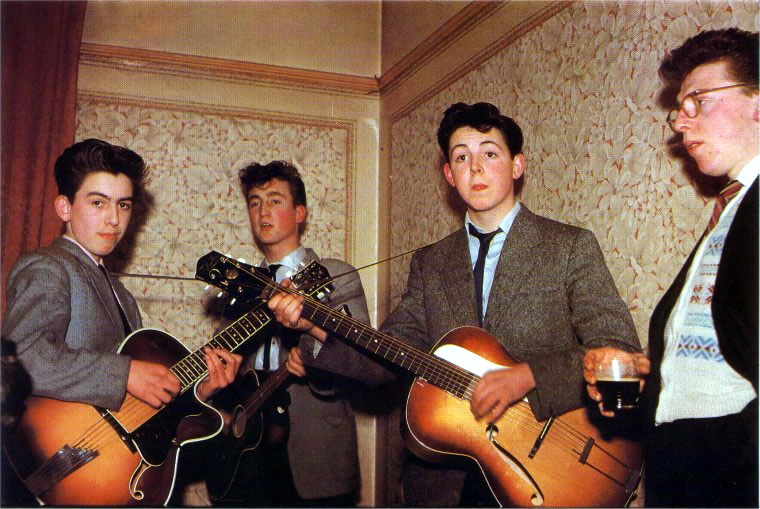
The Quarrymen soon to be Moondoggies
The industry as a whole was in a funk, sales had risen slowly following the Wertham debacle. Many retailers were stilled scared to stock any comics, let alone increase what little they had. Subscription service helped some fans get around weak distribution. DC had been seeing some growth due to the return of the Flash and success of Challengers of the Unknown. In a 1959 article, ABC the auditing bureau for comics sent out a missive in their monthly mailer, trying to spur growth. No mention of Atlas or other companies despite slow increases, which wasn’t unusual for the ABC. DC was still the largest and most respected of the publishers. They do note changes in the reading and entertainment habits of the children as well as adults with the growth of TV and paperbacks.
THE GREAT CHALLENGE OF THE COMIC (BOOK)
“During the past decade, retailers of periodicals have been living through tremendous years of decision. The last five years alone have seen several million-dollar developments for dealers, distributors and publishers. Some were gains… others were losses. The spectacular rise of paperback sales, for example, which now tops $12,000 per month. TV GUIDE, the little 15 cent weekly,is now earning around $1,200,000 in dealer profits every month! On the other hand, the Crowell-Collier magazines are no longer with us. The American News Company has folded. Millions of copies of many prominent titles formerly sold on the newsstands now reach their readers (buyers) via subscriptions! Comics dropped some 20,000,000 sales per month but are now creeping upwards again. Retailers do not always have an opportunity to participate in these momentous developments, all of which directly affect their profits. Right now, however, there is a great opportunity, a challenge really, to do something decisive about comics. During the past decade, comics hit the peaks… and the depths. Sales plunged from an estimated 60 million copies per month in 1952 to a low of approximately 30 million during the first few months of 1958. Today, sales are on their way up again, about 20 per cent better than last year! Behind this extreme variation in comics sales, is the dramatic life and death struggle of the most popular publication medium ever devised. Comics were soaring in the early fifties. In December, 1950, 303 new issues were released. This figure jumped to 434 in 1951 and 471 in 1952! These were the days of tremendous oversupply and great public agitation over sexy, gory and crime comics. That was the beginning of the decline. The numbers of issues per month slipped thereafter to 409, 321, 296… and sales proportionately! In the fall of 1954, the Comics Magazine Association of America established the Comics Code Authority to establish publishing standards and regulate contents accordingly. This industry organization was spectacularly successful! The minority of “nasty” comics were eliminated. The majority of acceptable titles became even more interesting and appealing. Public opinion wavered, then emphatically endorsed the comic as a healthy, wholesome medium of entertainment. The comic was saved! Normally, sales would have boomed a year or two after the Code Authority went to work, but another problem developed – television. It is no secret that today’s crop of potential young comics fans are plopped into their Baby Tendas and placed in front of the TV screen almost as soon as they are able to sit! They never get to acquire the comics habit as we used to know it. As a result, comics sales are somewhat improved, but they could and should be lots better!”
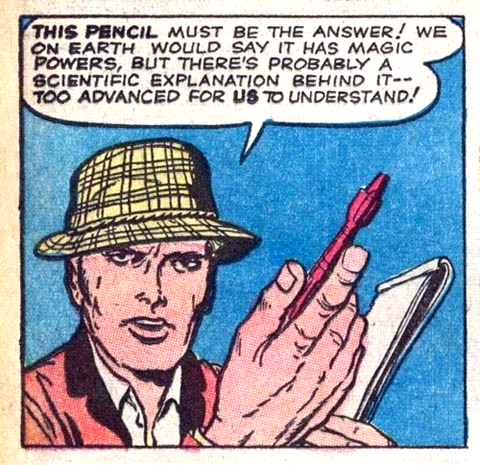
The decade was coming to an end. Never were Dickens’s words more prophetic. “It was the best of times, it was the worst of times.” Kirby was reduced to one comic account, but that one was giving him all he could handle. The decade held Jack’s most successful period. Yet the last couple years were as hard and painful as any he had ever had. His own company tanked, his parents had died, his partnership with his big brother ended, and he had been sued and humiliated by an editor. If there was to be a rebound, Kirby would have to do it by himself.
Previous – 14. The Art Of The Swipe | top | Next – 16. Kirby’s Kosmic Mystery
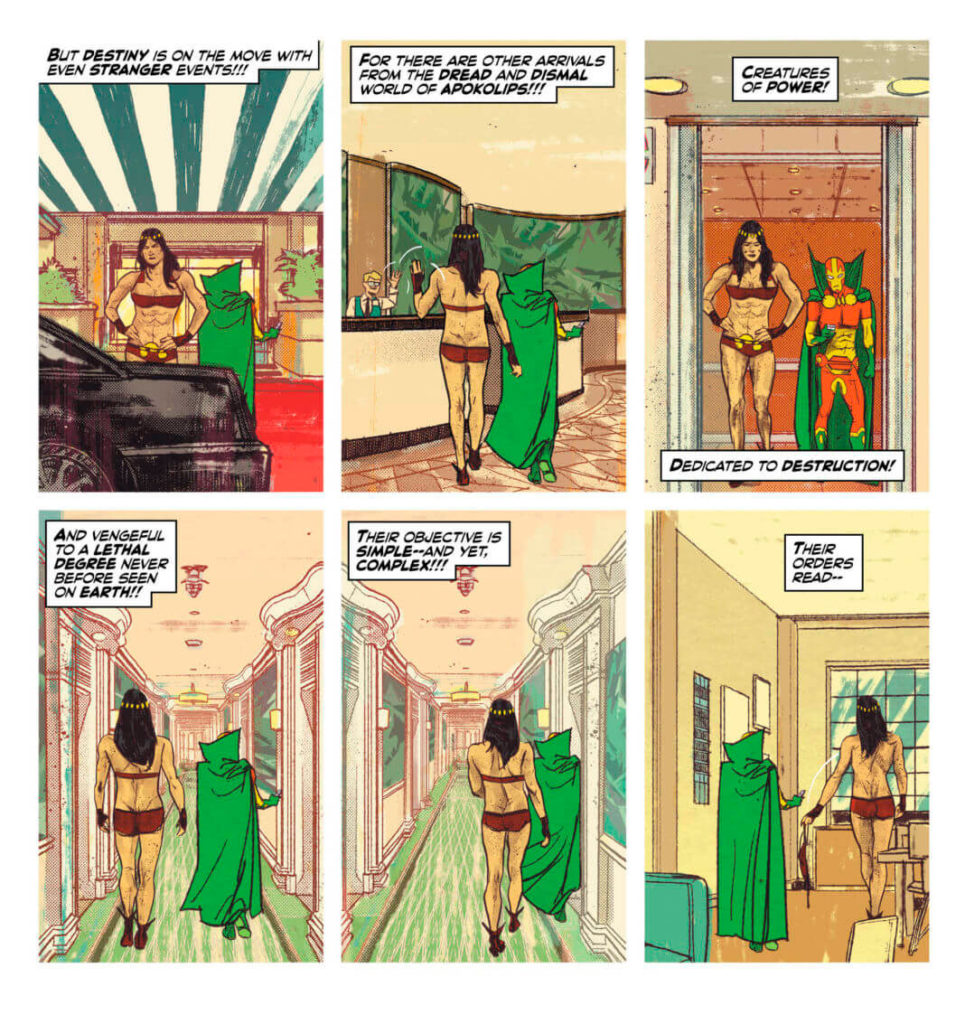 Gerads: Yep. Big Barda in “Mister Miracle” was fun. I’m really glad fans accepted it so quick, because in the past, there really hasn’t… most people don’t draw size difference. That always bugged me. Her name is Big Barda. If you don’t make her big, then what’s the point? So I put a good foot and a half difference. If Scott… if all the DC handbooks say Scott is six one. I think it says, like my Barda’s like seven something, maybe even close to eight. I’m just like, that’s genius, like that’s… not that’s genius. I’m calling myself a genius. Oh my god. To me, it just adds more fun and more… in a way it makes everyone more relatable. Any time you can add traits to characters and make them more relatable and human, I’ll take that all day long.
Gerads: Yep. Big Barda in “Mister Miracle” was fun. I’m really glad fans accepted it so quick, because in the past, there really hasn’t… most people don’t draw size difference. That always bugged me. Her name is Big Barda. If you don’t make her big, then what’s the point? So I put a good foot and a half difference. If Scott… if all the DC handbooks say Scott is six one. I think it says, like my Barda’s like seven something, maybe even close to eight. I’m just like, that’s genius, like that’s… not that’s genius. I’m calling myself a genius. Oh my god. To me, it just adds more fun and more… in a way it makes everyone more relatable. Any time you can add traits to characters and make them more relatable and human, I’ll take that all day long.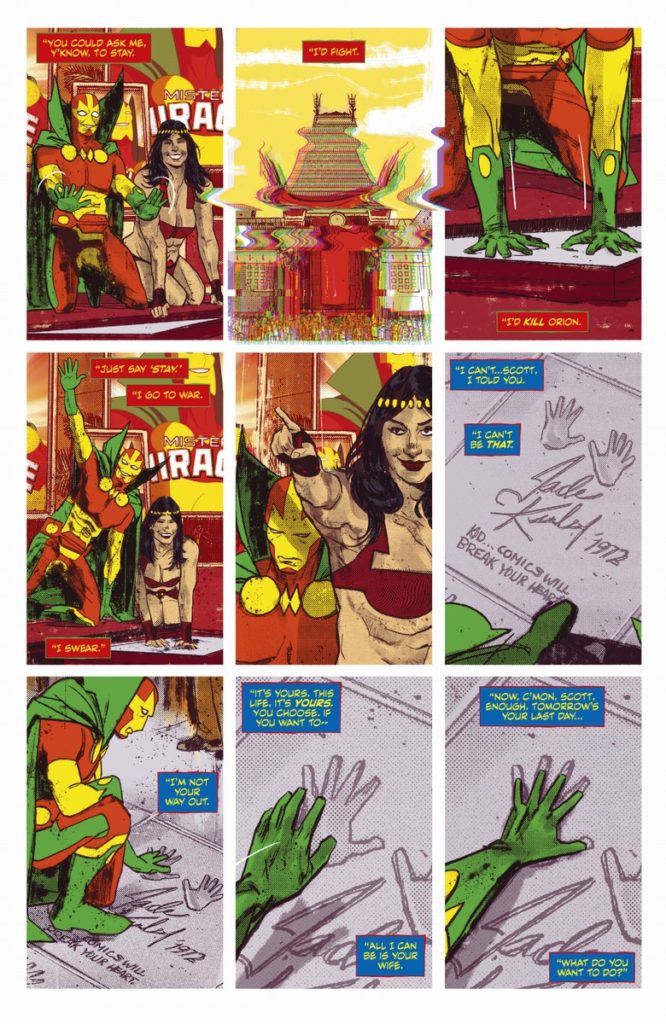 Gerads: Yeah, that’s everyone’s first inclination and the New Gods, across the board, have not been good sellers. Real rough going at almost every stop. Grant Morrison came close to real good selling with it, but… so me and Tom, that was our first thing we came across is that everybody was trying to be Jack Kirby, or really pay homage to Jack Kirby, which we are too, but in a different way. Our idea is you can’t out-Kirby Kirby, so why try? Even if you can get close, you’re never gonna be better than Kirby, so why try? Our idea is like, “Okay, let’s take all of the things Kirby was trying to do, and all the things that Kirby held highest in creativity and all these things and do that in the Tom King, Mitch Gerads way.”
Gerads: Yeah, that’s everyone’s first inclination and the New Gods, across the board, have not been good sellers. Real rough going at almost every stop. Grant Morrison came close to real good selling with it, but… so me and Tom, that was our first thing we came across is that everybody was trying to be Jack Kirby, or really pay homage to Jack Kirby, which we are too, but in a different way. Our idea is you can’t out-Kirby Kirby, so why try? Even if you can get close, you’re never gonna be better than Kirby, so why try? Our idea is like, “Okay, let’s take all of the things Kirby was trying to do, and all the things that Kirby held highest in creativity and all these things and do that in the Tom King, Mitch Gerads way.”

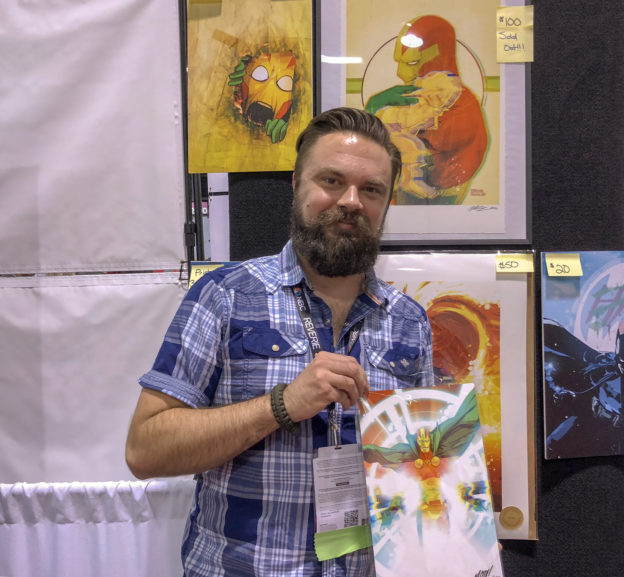









 Just as William Orr and Roy Huggins were beginning a collaboration that would dominate TV and Jack Kirby was beginning a collaborative pairing with Stan Lee that would shake the world of comics, in a small church in England a pair of teenagers were meeting whose partnership would transform not just music, but culture itself. A Liverpool England lad, John Lennon had formed a small skiffle band called the Quarrymen in 1956. While performing at St. Peter’s Church in Liverpool, John Lennon and Paul McCartney met and the pair found out that they have similar pop idol interests: “Paul, what kind of music do you like?” asked John. “Well I used to like Lonnie Donnegan but now that skiffle is fading out I love the music of Elvis Presley, Eddie Cochrane, Gene Vincent, Little Richard…”
Just as William Orr and Roy Huggins were beginning a collaboration that would dominate TV and Jack Kirby was beginning a collaborative pairing with Stan Lee that would shake the world of comics, in a small church in England a pair of teenagers were meeting whose partnership would transform not just music, but culture itself. A Liverpool England lad, John Lennon had formed a small skiffle band called the Quarrymen in 1956. While performing at St. Peter’s Church in Liverpool, John Lennon and Paul McCartney met and the pair found out that they have similar pop idol interests: “Paul, what kind of music do you like?” asked John. “Well I used to like Lonnie Donnegan but now that skiffle is fading out I love the music of Elvis Presley, Eddie Cochrane, Gene Vincent, Little Richard…”





































 In August, Sky Masters was just about to go to press. The strip looked great and all the work Kirby put into it showed on the strip. There had been some rumblings from Jack Schiff. Schiff approached Kirby and talked about renegotiating their verbal agreement for 4%. (The letter of intent was not a contract) According to Kirby, Schiff wanted a bigger piece, perhaps as much as a 10% sliding fee. Kirby was furious, he balked at original 4% because he didn’t believe that Schiff had done anything other than bring DC Elmlark and Wood/Kirby together. It wasn’t a Schiff sample that sold the strip. Schiff didn’t assist on the writing or art chores. Kirby said that Schiff made reference to his work at DC and how it might disappear if he didn’t cooperate. Kirby says it wasn’t done verbally, but with a wink and a nudge, as most strong arming is done. Kirby stood his ground, and in fact implied he might not even pay the 4%. The meeting ended with both sides upset, and still no signed agreement.
In August, Sky Masters was just about to go to press. The strip looked great and all the work Kirby put into it showed on the strip. There had been some rumblings from Jack Schiff. Schiff approached Kirby and talked about renegotiating their verbal agreement for 4%. (The letter of intent was not a contract) According to Kirby, Schiff wanted a bigger piece, perhaps as much as a 10% sliding fee. Kirby was furious, he balked at original 4% because he didn’t believe that Schiff had done anything other than bring DC Elmlark and Wood/Kirby together. It wasn’t a Schiff sample that sold the strip. Schiff didn’t assist on the writing or art chores. Kirby said that Schiff made reference to his work at DC and how it might disappear if he didn’t cooperate. Kirby says it wasn’t done verbally, but with a wink and a nudge, as most strong arming is done. Kirby stood his ground, and in fact implied he might not even pay the 4%. The meeting ended with both sides upset, and still no signed agreement.




























